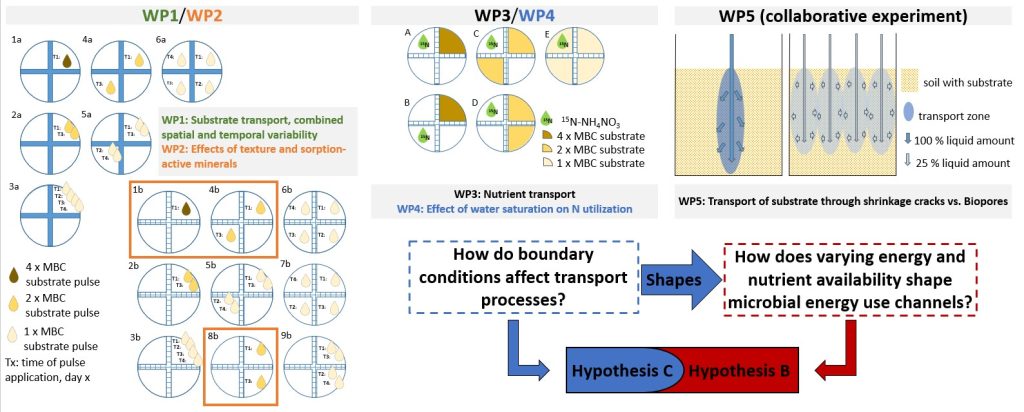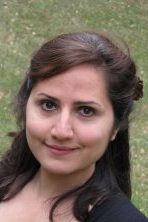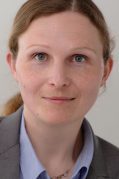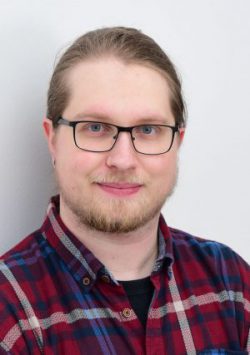Transport enhances the energy return on investment in the spatially and temporally heterogeneous soil environment

The scientific approach of project TrainSpaTEn is based on unraveling the interactions between spatial and temporal heterogeneities in substrate and nutrient availability and how their modulation by transport processes shapes microbial catabolism and anabolism in soil. The detailed objectives are:
- To study how transport of substrate or N improves substrate use efficiency (SUE) either due to the extending spatial distribution of the substrate to soil compartments where there is still sufficiently N available or due to N transport into substrate rich compartments where the nutrient is lacking.
- To analyze how the boundary conditions pore size distribution and sorption-active minerals alter the effect of transport processes on microbial energy and C use.
- To unravel to which extend the hypothesized positive impact of NO3– transport to substrate rich compartments on SUE is reduced by the need of the microbial community to partition NO3– under oxygen deficiency to denitrification and anabolism.
- To determine how preferential flow after drought and re-wetting steers timely water availability for the microbial community and thus the lag-phase of microbial reactivation and coinciding C flow through catabolic and anabolic pathways.
The Project comprises five work packages:
- Work package 1 focusses on the hypotheses that high amounts of C availability can lead to locally ceasing substrate decomposition because of N scarcity, saturation of cell wall transporters and reduced substrate mass transport in large microbial colonies. Transport of the substrate improves SUE due to the extending spatial distribution of the substrate to soil compartments where there is still sufficiently N available to avoid nutrient limitation. And if the transported substrate itself already provides sufficient N to cover the N demand of the microbial community, assuming that N scarcity is a major factor causing low SUE at high spatial heterogeneity of substrate availability, the effect of the transport on SUE will decrease.
- Work package 2 will unravel if a dominance of large pores will allow rapid transport at high soil water contents, but significantly reduce the transport already at pF 1.8, because the high proportion of air-filled porosity does no longer allow for continuous hydraulic gradients to develop. Although a dominance of fine pores will allow for transport over a wider range of water contents, the transport will be very slow, so that the positive effects of transport on SUE and microbial energy return on investment are likely largest in soils with medium sized pores. Work package 2 will also clarify to which extent the content of sorption-active minerals in the soil affects the availability of sorptive molecules in the soil solution because of rapid adsorption, so energetic investments in these molecules is less rewarding in highly sorptive soils, even if the molecules are potentially easily metabolized.
- Work package 3 will show if the transport of easily available N to soil compartments with an excess of substrate can prevent priming of soil native C for N-mining, and to which degree the SUE of lignocellulose degradation is enhanced because the microbial community does not need to invest energy into the production of extracellular enzymes for native SOM degradation to mine for N.
- Work package 4 will test if the positive effect of the N transport on the SUE of lignocellulose is reduced in a water saturated soil, not only because of oxygen deficiency, but also because part of the N is lost via denitrification processes, and if the partitioning of N to denitrification, and thus gaseous losses, will be larger in soils were the microbial community is already adjusted to phases with oxygen deficiency.
- Work package 5 is part of a joint experiment on functional complexity (with Universität Hohenheim) that investigates the response of soils of varying complexity to stressors, like drying and wetting events. The contributions of TrainSpaTEn to this joint experiment will show how preferential flow in the rewetting procedure steers the timely water availability for the microbial community and thus the lag-phase of microbial reactivation, which will become evident in CO2 release and heat dissipation. We will also reveal if more severe drying will extend the lag-phase of microbial reactivation by rewetting depending on the complexity of the microbial community, and if the enrichment of the infiltrating water with (re)dissolved organic matter from (bio)pore walls can benefit the microbial reactivation and shorten the lag-phase.
Link to English scientific abstract
Link to German scientific abstract
Link to project in the 1st phase
Research Team

Project Leader
s.spielvogel@soils.uni-kiel.de

Project Leader
brazavi@phytomed.uni-kiel.de

Project Leader
i.zimmermann@soils.uni-kiel.de

PhD Student
c.lorenzen@soils.uni-kiel.de

PhD Student
N/A
Christian-Albrechts-Universität Kiel
Faculty of Agricultural and Nutritional Sciences
Institute for Soil Science
Soil and Plant Microbiome Department